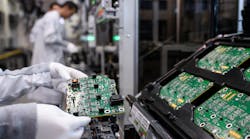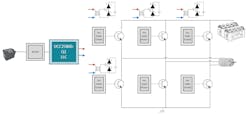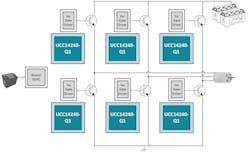As the auto industry prepares for the electric vehicle era, many of the world's auto makers are investing in safer batteries that charge faster and last longer per charge than lithium-ion batteries currently in use. But Texas Instruments is trying to wring more efficiency gains out of the largest, heaviest part of the EV: the powertrain, a family of components that pulls electricity stored in the battery and routes it to the wheels.
A new isolated dc-dc bias-supply module introduced by TI uses proprietary integrated transformer technology to reduce the area and weight of the power electronics in EVs. The UCC14240-Q1 brings more power density and efficiency at the system level, allowing EVs to travel longer distances on a single charge.
TI said the chip is based on its unique integrated transformer technology that can shrink the high-voltage electronics in electric vehicles by up to 50% while packing more power inside. The chip runs at 60% efficiency, doubling the power density of a traditional bias supply in a smaller package that dissipates less heat, which ultimately saps energy efficiency or causes system failures. The company said that this helps customers reduce costs without compromising on functional safety at the system level.
These properties also are ideal for wringing significantly more electricity out of motor-drive and renewable-energy systems, grid-tied inverters, and other areas TI is targeting with the new power supply module.
Every EV powertrain has several major building blocks. The onboard charger converts alternating current (ac) from the electric grid to direct current (dc) and then uses it to recharge the EV’s depleted battery. The traction inverter is at the heart of the powertrain, which converts electricity to propel the electric motor. Many electric vehicles also have secondary inverters—also called auxiliary inverters—to supply loads to smaller electric motors that control power steering, active chassis control, or HVAC systems.
Electric vehicles also come equipped with a dc-dc converter that “steps down” voltages from the battery to control body electronics, such as the headlights, side mirrors, or power windows, which require lighter loads.
The power electronics in EVs are generally based on high-voltage insulated gate bipolar transistors (IGBTs) and, increasingly, silicon-carbide (SiC) FETs. These chips are predominately used as electronic switches that distribute power to the motor turning the wheels or other EV systems in a way that limits power losses and improves reliability. Every switch is supplemented by a gate driver that turns them on and off (Figure 1).
Usually, a single isolated dc-dc power supply delivers “bias” voltages to all the driver ICs in the system. The bias supply uses one central transformer and a single dc-dc converter surrounded by a wide range of other components on the PCB. A major advantage of this architecture is that it keeps costs in check, according to TI. But it has also struggled with managing faults and regulating the voltages moving throughout the system.
Tall, heavy transformers also add weight to the powertrain and hoard valuable space on the circuit board (PCB). They are also more vulnerable to the harsh temperatures, noise, and vibrations in electric vehicles.
To improve range and redundancy, car manufacturers are moving to a more distributed architecture—a scheme where every gate driver is paired with a dedicated bias power supply. TI said that improves how the vehicle’s powertrain reacts to failures on the road: If one bias power supply fails, the other components can continue operating as usual, along with the gate drivers, helping keep the vehicle safely on the road (Figure 2).
But the bulky, box-shaped transformers currently in use are out of the question in distributed architectures. They would add too much weight and take up too much space on the PCB, hurting power density.
TI, which is wrestling with Analog Devices, Infineon Technologies, Renesas Electronics, and others to win slots in electric vehicles, said the UCC14240-Q1 can help its customers move to a more distributed internal architecture. By delivering more than 1.5 W of output power at temperatures of 105°C, TI said that it could support IGBTs as well as SiC and gallium-nitride (GaN) FETs that switch faster and handle higher voltages.
By integrating the transformer, dc-dc bias converter, and other parts in the same module, it is possible to reduce the area, cost, and weight of the power electronics in the EV. TI said the new module reduces the footprint of the final power supply by up to 50% and obsoletes more than 15 components. The chip, which supports input voltages of 21 to 27 V (with a 32 V maximum), can withstand temperatures of −40 to 150°C.
TI said the module’s height is also significantly less than a power supply using a traditional transformer. TI said that this gives customers more flexibility in PCB layout.
Power density is another priority TI is trying to address in electric vehicles. The company said the dual-output module runs at up to 60% efficiency, double the performance of power suppliers currently in use. Even small efficiency gains in converting voltages from one level to another add up when they happen many times, as in electric vehicles that change speeds constantly. The chip also features adjustable isolated output voltages.
The higher power density possible with the new module allows customers to roll out power electronics that are smaller, weigh less, and have higher power efficiency so EVs can travel longer distances on a charge.
Heat buildup is one of the primary culprits of component failures in cars. This is why the power supply module’s ability to run with a high degree of energy efficiency (and at cooler temperatures) is so valuable to manufacturers.
The automobile-grade module uses integrated closed-loop control to regulate voltages to within 1%. The tight tolerance allows car manufacturers to use more compact, efficient switches, including SiC and GaN FETs.
Last year, TI rolled out a 500-mW isolated dc-dc bias power supply for high-voltage systems and renewable-powered grids, the UCC12050, which featured its integrated transformer technology for the first time.
Other improvements are on the functional safety front. Fault tolerance features include undervoltage and overvoltage lockout, overcurrent protection, overtemperature shutdown, and soft-start timing. In addition, TI said that the integrated transformer ups the isolation to 3000 V rms in a smaller package than flyback, push-pull, or other legacy architectures using a single transformer that delivers only about 2000 V rms of isolation.
The reduced weight also allows it to better tolerate vibrations, TI said.
TI said that the bias supply is also designed to dampen the electromagnetic interference (EMI)(\ discharged by the car’s internal electronics, including high-speed switches. The integrated transformer technology in the power supply lessens primary-to-secondary capacitance, protecting it against common-mode transients. Soft-switching, shielding, and other fault-tolerance features also help tamp down EMI, the company said.
Customers can buy pre-production quantities of the new UCC14240-Q1 in 12.8- × 10.3- × 3.55-mm SOIC packages. Pricing starts at $4.20 in orders of 1,000 units.


